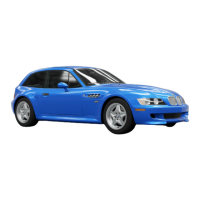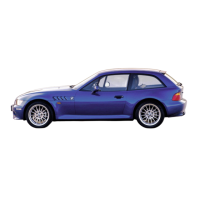
Do you have a question about the BMW Z3 roadster 3.0i and is the answer not in the manual?
| Brand | BMW |
|---|---|
| Model | Z3 roadster 3.0i |
| Category | Automobile |
| Language | English |
Explains symbols used for warnings, precautions, and notes in the manual.
Emphasizes using genuine BMW parts and accessories for safety and performance.
Warns about potential damage and warranty issues with non-approved accessories.
Details that emission control system maintenance can be done by any certified repair establishment.
Indicates consulting the Owner's Manual for specific part information.
Provides a general introduction and summary of the vehicle's features.
Details the various controls and functional features of the vehicle.
Covers how to operate and maintain the vehicle for optimal performance.
Guides owners on basic service tasks and procedures they can perform.
Explains complex technological systems and features in the vehicle.
Provides specifications and technical details about the vehicle.
Alphabetical listing of topics for quick reference.
Instructions for operating doors, windows, sunroof, and convertible top.
Details on adjusting seats and mirrors for driver comfort and visibility.
Information on seat belts, airbags, and child safety restraints.
Guidance on ignition, starting the engine, parking brake, and transmissions.
Explanation of gauges like odometer, fuel, coolant, and indicator lamps.
Details on systems like ASC+T and DSC for stability and control.
Information on exterior and interior lighting controls and functions.
Covers operation of heating, ventilation, and air conditioning.
Covers break-in procedures, driving notes, ABS, and hardtop operation.
Details on hood, fluids, engine oil, coolant, and vehicle identification.
Information on the maintenance system and vehicle storage.
Covers technical modifications, California Proposition 65, and OBD socket.
Explains the function and operation of the ATC system.
Provides technical details related to the airbag system.
Technical specifications for stability and traction control systems.
Technical details regarding the seat belt tensioner mechanism.
Layout and components of the cockpit and instrument cluster.
Explanation of various indicator and warning lamps on the dashboard.
Information on warning triangle and first-aid kit.
Basic information on fueling and tire pressure checks.
Explains the Service Interval Display and its indicators.
Details the function and usage of the odometer.
Provides a list and explanations for various dashboard warning lamps.
Critical warnings indicating immediate action is required for safety or to prevent damage.
Indicates when the parking brake is engaged or if there's a system fault.
Informs about the airbag system's readiness or potential malfunctions.
Explains yellow indicators for ABS deactivation and low engine oil level.
Indicates faults in stability control or brake systems.
Alerts to faults in the emissions-related electronic systems.
Signals a fault in the engine's electronic control system.
Location and usage instructions for the warning triangle.
Information on the first-aid kit contents and maintenance.
Safety guidelines for handling fuel and transporting fuel containers.
Guidelines for complying with BMW-approved tire specifications.
Detailed operation of keys, locks, windows, sunroof, and convertible top.
Instructions for adjusting seats and mirrors for optimal comfort.
Information on seat belts, airbags, and child safety.
Guidance on ignition, engine starting, parking brake, and transmission.
Details on location and use of storage compartments and locking boxes.
Information on the beverage holder and storage tray.
Usage and power limitations of the cigarette lighter socket.
Guidance on loading and securing cargo, including partition net.
Instructions for obtaining and initializing replacement keys.
Description of the key with integrated remote control unit.
Instructions for locking/unlocking doors using the vehicle key.
How to use convenience locking mode with power windows.
Using the remote control to lock and secure the vehicle.
How to turn on interior lamps using the remote control.
Instructions for opening and closing the luggage compartment lid from inside.
Details on the lock mechanism for the luggage compartment lid.
Instructions for operating the electric power windows.
Step-by-step guide for operating the coupe's sunroof.
Instructions for correctly mounting the convertible top cover.
Steps for safely removing the convertible top cover.
Step-by-step guide for safely opening the convertible top.
Recommendations for achieving a correct and comfortable sitting posture.
Instructions for adjusting the exterior rearview mirrors.
Operation of the interior rearview mirror and sun visors.
Correct routing of safety belts for different models.
How to adjust the safety belt height for optimal fit.
Guidelines for proper use, care, and inspection of safety belts.
Explains the airbag system's readiness indicator lamp.
Safety recommendations for installing child restraints near airbags.
Rules for installing rear-facing child restraints and general child safety.
Methods for securing child restraints using seat belts and tether straps.
Guidance on unlocking the steering wheel for ignition.
Steps to turn on the vehicle ignition and activate systems.
Instructions for starting the vehicle's engine.
How to engage the parking brake and indicator lamp function.
Steps for safely releasing the parking brake.
Explanation of Steptronic selector lever positions (P, R, N, D, M/S).
How to disengage the selector lever lock (Shiftlock).
Explanation of turn signal and high beam indicator lamps.
How to use turn signals for brief signaling.
How to position wipers vertically for cleaning or service.
Description of different wiper speed settings.
Procedure for cleaning the windshield using washer fluid.
Notes on headlamp activation and usage.
Operation of the rear window defroster.
Information on windshield washer nozzle adjustment.
How to set, maintain, and accelerate speed with cruise control.
Using cruise control to resume a previously stored speed.
Methods to deactivate the cruise control system.
Explanation of the odometer and fuel gauge readings.
Interpretation of green, yellow, and red lamps for maintenance status.
How to access and select different data displays from the computer.
Instructions for setting and displaying the vehicle's time.
Procedure for switching between 12-hour and 24-hour time displays.
Explanation of the ice warning system based on outside temperature.
How the onboard computer calculates estimated cruising range.
Process for calculating the vehicle's average speed.
Explains the ASC+T indicator lamp and system functionality.
Situations and procedure for temporarily switching off ASC+T.
Explains the DSC system's role in maintaining vehicle stability.
Interpretation of the DSC indicator lamp status.
Procedure and implications of switching off DSC and ADB.
Steps to reactivate the DSC and ADB systems.
Warning for when headlamps are not switched off.
Information on automatic activation of daytime driving lamps.
How to operate the front fog lamps and their indicator.
Operation modes for front interior lamps in the coupe.
Operation modes for rear interior lamps in the coupe.
Adjusting air outlets for optimal ventilation and comfort.
Steps for quickly achieving desired interior ventilation.
Procedure for defrosting windows and removing condensation.
Detailed steps for defrosting and clearing condensation.
How the AC cools and dehumidifies the cabin air.
Using recirculated air mode to improve interior air quality.
Adjusting manual ventilation settings for comfort.
Steps for operating the cooling system effectively.
Instructions for operating the heating system.
Steps for defrosting windows and removing condensation.
Details on the location of various storage compartments.
How to operate and lock the storage boxes.
Instructions for opening and emptying the vehicle's ashtray.
How to access the socket when the non-smoker's package is fitted.
Guidelines for correctly positioning and securing cargo.
Locating the hood release and accessing the engine compartment.
Information on checking various vehicle fluids and washer systems.
Guidance on checking engine oil and coolant levels.
Locating the vehicle identification number (VIN).
Explanation of the BMW Maintenance System and service intervals.
Steps for preparing and storing the vehicle for extended periods.
Warning regarding chemicals potentially causing cancer or birth defects.
Details about the On-Board Diagnostics (OBD) interface socket.
Guidelines for breaking in the brake system components.
Recommendations for breaking in the clutch.
Safety advice for driving through water.
Instructions for using interior hooks safely.
Explanation of how the ABS system functions during braking.
Details on brake system performance and potential issues.
Advice for driving in wet conditions and on descents.
Indicates low brake fluid level and potential causes.
Signals when brake pads have reached minimum thickness.
Recommendations for caring for weather seals and components.
Guidelines for installing and using snow chains.
Advice for starting and driving on slippery surfaces.
Notes on brake performance and stopping distances in winter.
Precautions for steering control and potential issues.
Instructions for checking and maintaining correct tire inflation pressure.
Guidance on inspecting tires for wear, damage, and tread depth.
Recommendations for replacing tires and using single tread configurations.
Explanation of DOT quality grades for tread wear, traction, and temperature.
Explanation of tire temperature grades (A, B, C).
Explanation of the Uniform Tire Quality Grading system.
Recommendations and guidelines for rotating tires between axles.
Understanding tire sidewall codes, including speed ratings.
Explanation of codes found on light-alloy wheels.
Proper methods for storing tires to maintain their condition.
Advice on tire condition and pressure when using snow chains.
Locating the hood release lever under the instrument panel.
Step-by-step instructions for opening the vehicle's hood.
Adjusting windshield washer nozzles for optimal cleaning.
Information on servicing the headlamp washer system.
Procedure for checking the engine oil level using the dipstick.
Guidelines for adding engine oil and avoiding additives.
Instructions for checking the coolant level when the engine is cold.
Explanation of how the Service Interval Display determines maintenance needs.
Steps for preparing the vehicle for long-term storage.
Guidelines for maintaining the battery during vehicle storage.
Steps for preparing the vehicle after storage.
Understanding the service indicator light and its meaning.
How the OBD system detects issues related to the fuel filler cap.
Information on using the onboard tool kit for repairs.
Procedure for replacing windshield and rear wiper blades.
General guidance for replacing various vehicle bulbs.
Steps for replacing key batteries and master keys.
Proper disposal procedures for vehicle fuses.
Troubleshooting steps for convertible top malfunctions.
Troubleshooting procedures for fuel filler door issues.
Step-by-step guide for jump-starting a vehicle.
Instructions and safety precautions for towing the vehicle.
Procedure for replacing the front windshield wiper blades.
Instructions for replacing the rear wiper blade on Z3 Coupe models.
Procedure for replacing high beam headlamp bulbs.
Procedure for replacing low beam headlamp bulbs.
Safety and cleaning guidelines for headlamp covers.
How to replace the bulb in the front turn signal lamps.
How to replace the bulb in the side turn signal lamps.
Details on the types and wattages of tail lamp bulbs.
Troubleshooting and replacement for the high-mount brake lamp.
Procedure for replacing license plate lamp bulbs.
How to replace bulbs in the interior side lamps.
Procedure for replacing bulbs in the reading lamps.
Steps to initialize a new master key with remote control.
Inventory and arrangement of tools in the onboard tool kit.
Proper and safe procedures for using the vehicle jack.
Steps for removing the spare wheel from the coupe's storage.
Steps for removing the spare wheel from the roadster's storage.
Procedures to secure the vehicle before changing a wheel.
Instructions for removing wheel covers.
Steps for loosening lug bolts before removing a wheel.
Correct placement of the jack at the jacking point.
Instructions for using the centering pin during wheel installation.
Proper sequence for tightening lug bolts.
Precautions when using non-original alloy wheels.
Basic care instructions for vehicle batteries.
Explanation of safety symbols related to batteries.
Essential safety precautions when working with vehicle batteries.
Instructions for charging the vehicle battery.
Guidance on proper storage of the vehicle battery.
Location of the fuse box and information on fuse ratings.
Safety guidelines and warnings for replacing fuses.
Procedure for manually opening the fuel filler door.
Step-by-step guide for safely connecting jumper cables.
Instructions for installing and using the vehicle's tow fitting.
How to access the vehicle's tow sockets.
Specific towing instructions for automatic transmission vehicles.
Information on the Adaptive Transmission Control system.
Detailed technical information about the airbag systems.
Explanation of the functions of ASC+T and DSC systems.
Details on the operation of the seat belt tensioner.
Conditions and sensors that trigger airbag deployment.
How DSC sensors monitor vehicle dynamics and adapt to conditions.
Key engine specifications including displacement and power.
Overall dimensions of the vehicle.
Information on vehicle weights, including curb and gross weights.
Capacities for various vehicle fluids like oil, coolant, and fuel.
Specifications for engine drive belts.
Space to enter preferred fuel type.
Space to record engine oil capacity.
Space to record tire inflation pressures.











